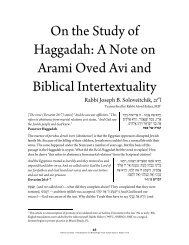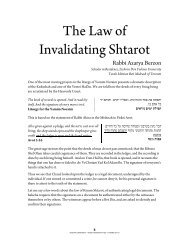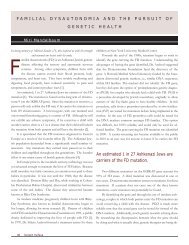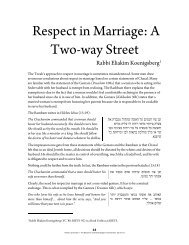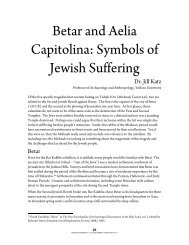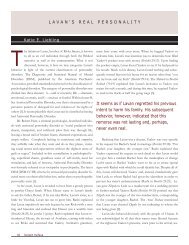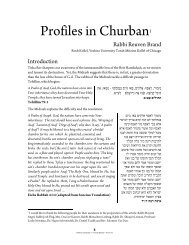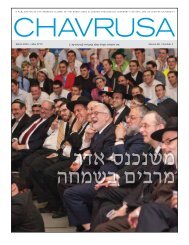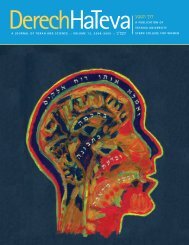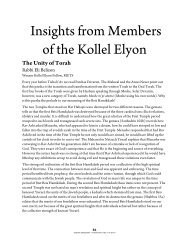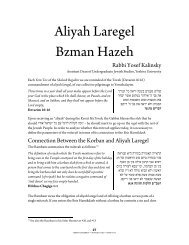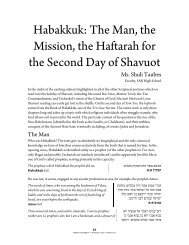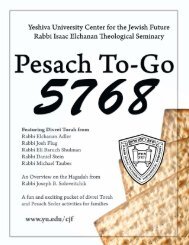YESHIVA UNIVERSITY • SUKKOT TO-GO ... - YU Torah Online
YESHIVA UNIVERSITY • SUKKOT TO-GO ... - YU Torah Online
YESHIVA UNIVERSITY • SUKKOT TO-GO ... - YU Torah Online
You also want an ePaper? Increase the reach of your titles
YUMPU automatically turns print PDFs into web optimized ePapers that Google loves.
engaging in this practice is because receiving forgiveness from one another is indispensable to<br />
receiving Divine atonement (see Yoma 85b). However, a passage in the Yom Kippur machzor<br />
(found just after the Seder Avoda) suggests another dimension as well. After listing the various<br />
halachic restrictions which characterize Yom Kippur, the machzor includes two additional<br />
features:<br />
A day of establishing love and friendship; a day of<br />
abandoning jealousy and competition<br />
6<br />
<strong>YESHIVA</strong> <strong>UNIVERSITY</strong> <strong>•</strong> <strong>SUKKOT</strong> <strong>TO</strong>-<strong>GO</strong> <strong>•</strong> TISHREI 5771<br />
תורחתו האנק תביזע םוי , תוערו הבהא תמיש םוי<br />
Apparently, Jewish unity is as defining an aspect of Yom Kippur as are the basic restrictions. It is<br />
no wonder, then, that our Yom Kippur preparations require us to make amends with those<br />
whom we have wronged.<br />
The heightened sense of achdus which characterizes Yom Kippur serves as a basis for equating<br />
the Jewish nation with the angels in heaven, as suggested by the following midrash:<br />
Just as amongst the angels there is peace, so the Jewish<br />
nation on Yom Kippur<br />
(Tur OC, 606, based on Pirkei de’Rebbi Eliezer).<br />
לארשי ךכ םהיניב םולש תרשה יכאלמ המ<br />
םירופיכה םויב<br />
( א"<br />
רד יקרפ םשב , ורת ןמיס , ח"<br />
וא רוט)<br />
Moreover, the Yom Kippur liturgy begins (just before commencing Kol Nidrei) with a<br />
declaration of license to pray along with the avaryanim – unrepentant sinners.<br />
Yom Kippur – “The Day of One”<br />
The centrality of Jewish harmony to Yom Kippur may be understood on a deeper level in light of<br />
the following midrash:<br />
R. Yanai said: From the beginning of creation Hashem foresaw<br />
the deeds of the righteous and the deeds of the wicked. “And the<br />
land was astonishingly empty” – refers to the deeds of the<br />
wicked; “And G-d said: ‘Let there be light’” – refers to the deeds<br />
of the righteous; “And G-d separated between the light and the<br />
darkness” – between the deeds of the righteous and those of the<br />
wicked; “And G-d called the light ‘day’” – refers to the deeds of<br />
the righteous; “And to the darkness He called ‘night’” – refers to<br />
the deeds of the wicked; “And it was evening” – refers to the<br />
deeds of the wicked; “And it was morning” – refers to the deeds<br />
of the righteous; “One day” – that Hashem gave them one day,<br />
which is Yom HaKippurim”<br />
Bereishis Rabba 3<br />
םלוע לש ותיירב תלחתמ יאני ר"<br />
א<br />
םיקידצ לש ןהישעמ ה"<br />
בקה הפצ<br />
התיה ץראהו , םיעשר לש םהישעמו<br />
רמאיו םיעשר לש םהישעמ ולא והת<br />
לש ןהישעמ ולא רוא יהי םיהלא<br />
ןיבו רואה ןיב םיהלא לדביו , םיקידצ<br />
םיקידצ לש ןהישעמ ןיב ךשוחה<br />
םיהלא ארקיו , םיעשר לש ןהישעמל<br />
, םיקידצ לש<br />
ןהישעמ ולא םוי רואל<br />
לש ןהישעמ ולא הליל ארק ךשוחלו<br />
לש ןהישעמ ולא ברע יהיו , םיעשר<br />
לש ןהישעמ ולא רקב יהיו , םיעשר<br />
ה"<br />
בקה םהל ןתנש , דחא םוי , םיקידצ<br />
םירופכה םוי הז הזיאו דחא םוי<br />
ג השרפ , הבר תישארב<br />
The midrash interprets the series of dichotomous expressions which appear in the pasuk as<br />
alternate references to the deeds of tzadikim and the deeds of resha’im. After a string of contrasts,



